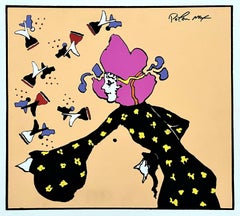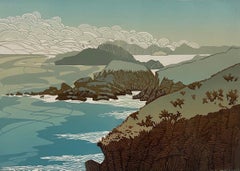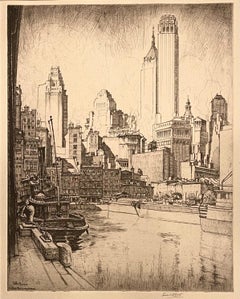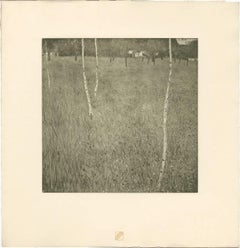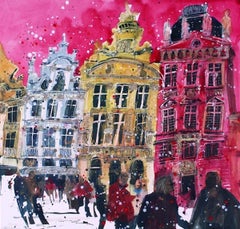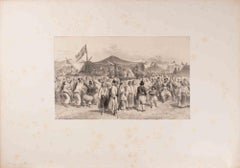Small Landscape Prints
to
1,057
7,981
3,202
2,859
1,608
1,198
Overall Width
to
Overall Height
to
760
610
191
148
135
118
89
80
60
14
8
8
2
2
72
61
61
34
30
274
478
1,711
737
30
14
100
66
76
163
327
347
183
113
139
1,914
1,148
134
1,272
590
452
382
372
304
255
252
217
190
174
151
132
132
131
131
115
106
102
88
1,219
851
527
272
235
396
875
1,937
1,044
Size: Small
Galaxy Lady, Peter Max
By Peter Max
Located in Fairfield, CT
Artist: Peter Max (1937)
Title: Galaxy Lady
Year: 1972
Edition: T.P.; 300, plus proofs
Medium: Silkscreen on wove paper
Size: 16 x 18.5 inches
Condition: Good
Inscription: Signed by ...
Category
1970s Pop Art Figurative Prints
Materials
Screen
$2,600 Sale Price
33% Off
Cliff Edge, Seascape Art, Cliff Art, Blue and Green Seascape Art, Coastal Art
By Ian Phillips
Located in Deddington, GB
Cliff Edge is a limited edition reduction linocut print by Ian Phillips.
Ian Phillips is available online and in our gallery at Wychwood Art. My printing process starts today, as it’...
Category
2010s Contemporary Landscape Prints
Materials
Paper, Linocut
FROM PIER 4 - EAST RIVER
Located in Portland, ME
Roth, Ernest (American, 1879-1964). FROM PIER 4 - EAST RIVER. Etching, not dated. Edition size not stated. Signed in Pencil, and titled in pencil at the lower edge, and Signed, dated...
Category
Mid-20th Century Landscape Prints
Materials
Etching
H.O. Miethke Das Werk folio "Farmhouse With Birch Trees" collotype print
Located in Palm Beach, FL
DAS WERK GUSTAV KLIMTS, a portfolio of 50 prints, ten of which are multicolor collotypes on chine colle paper laid down on hand-made heavy cream wove paper with deckled edges; under ...
Category
Early 1900s Vienna Secession Landscape Prints
Materials
Paper
Brussels Theatrical Centrepiece, Bright Impressionist Print, Art of Belgium
Located in Deddington, GB
Cities 4 – Brussels’ Theatrical Centrepiece by Susan Brown.
Hand signed by the artist
“Walking through La Grand Place in Brussels, is taking a journey t...
Category
21st Century and Contemporary Abstract Impressionist Figurative Prints
Materials
Giclée, Paper
Camp et Fête en Roumanie - Lithograph by Auguste Raffet - 1840s
Located in Roma, IT
Lithograph, c. 1840s
Image dimension 19.5x32 cm.
Signed in the plate.
A dynamic and finely observed lithograph by Auguste Raffet, depicting a festive gathering in a Romanian milit...
Category
1840s Modern Figurative Prints
Materials
Lithograph
Campement en Valachie - Lithograph by Auguste Raffet - 1840s
Located in Roma, IT
Lithograph, c. 1840s.
Signed in the plate.
Image dimension: 17x27.5 cm.
A finely detailed lithograph by Auguste Raffet, representing a bustling encampment in Wallachia. In the cen...
Category
1840s Modern Figurative Prints
Materials
Lithograph
Le Château de Georges, Valachie - Lithograph by Auguste Raffet - 1839
Located in Roma, IT
Lithograph, c. 1840s
Signed and dated in the plate.
Image dimension: 17x29 cm.
A rare lithograph by Auguste Raffet, depicting the Château de Georges in Wallachia. The composition ...
Category
1830s Modern Figurative Prints
Materials
Lithograph
Tour à Rhotaye - Lithograph by Auguste Raffet - 1839
Located in Roma, IT
Lithograph, c. 1840s
Signed and dated in the plate.
Image dimension: 23x21 cm.
An evocative lithograph by Auguste Raffet, depicting a tall defensive tower rising starkly against t...
Category
1830s Modern Figurative Prints
Materials
Lithograph
The Norfolk Broads by Kate Heiss, Limited edition print, Landscape, Wildlife
By Kate Heiss
Located in Deddington, GB
The Norfolk Broads [2022]
limited_edition and hand signed by the artist
Oil based inks on 300GSM Somerset Velvet Paper
Edition number 15
Image size:...
Category
21st Century and Contemporary Expressionist Landscape Prints
Materials
Paper, Ink, Mixed Media
H.O. Miethke Das Werk folio "Beech Forest II" collotype print
Located in Palm Beach, FL
DAS WERK GUSTAV KLIMTS, a portfolio of 50 prints, ten of which are multicolor collotypes on chine colle paper laid down on hand-made heavy cream wove paper with deckled edges; under ...
Category
Early 1900s Vienna Secession Landscape Prints
Materials
Paper
Bennett: Bowling Green, New York, 1826
Located in Chesterfield, MI
Historical Print entitled "Bennett: Bowling Green, New York" 1826 as noted in bottom Left Corner
It was published by Rudolf Leach Fine Arts, Inc.,
225 Fifth Avenue, New York City
...
Category
1820s Realist Landscape Prints
Materials
Lithograph
$120 Sale Price
20% Off
Escape from Troy - Lithograph by Eugène Berman - 1967s
Located in Roma, IT
Escape from Troy 1967s is a watercolored lithograph on ivory-colored paper, realized by Russian scenographer Eugène Berman.
Hand-signed and not numbered, as issued.
Image Dimension:...
Category
1960s Modern Figurative Prints
Materials
Lithograph
RAINY SUNDAY AT SAN MARCO
Located in Portland, ME
Hornby, Lester. RAINY SUNDAY AT SAN MARCO. Falk, 308, Kennedy 32. Etching, 1908. Edition of 60. Titled and signed in the plate and signed in pencil in the margin, lower right. 5 7/8 ...
Category
Early 1900s Landscape Prints
Materials
Etching
17th century etching black and white landscape scene forest trees figures sky
Located in Milwaukee, WI
"Le Temps, Apollon, et les Saisons (Time, Apollo, and the Seasons)" is an etching by Claude Gellée (Le Lorrain). This etching is the Fifth state (A). This state is also in collections in Paris (BN, L, PP) and Washington; Mannocci cat. no. 43. The inscription reads: "Apollo in atto di obedire al tempo. La Primavera a cominciare il ballo. Lestate no manca del suo calore. L'aurunno colsuo licore / Seguita. Linvernno tiene la sua staggione, Claudio Gillee inven.Fec.Roma 1662 con licenza de super."
A powerful example of Claude's staging of landscape in the classical manner is the etching "Time,
Apollo, and the Seasons," done in 1662 after Poussin's painting of 1624-1636, "Dance to the Music of Time...
Category
Mid-17th Century Old Masters Landscape Prints
Materials
Etching
Gold Leaf, Anna Harley, Tree Art, Contemporary Landscape Print, Calm Art, Blue
By Anna Harley
Located in Deddington, GB
Anna Harley.
Gold Leaf
Limited Edition Screen Print.
Edition of 30
Sheet Size: H 57cm x W 57cm x D 0.1cm
Sold Unframed
Please note that in situ images are purely an indication of how...
Category
21st Century and Contemporary Contemporary Still-life Prints
Materials
Paper, Screen
Tomas Sanchez, Cascada como icono, 2025
Located in Miami, FL
Tomas Sanchez
Cascada como icono, 2025
UV pigment print
22 x 22 in
Ed 337 of 431
Category
21st Century and Contemporary Contemporary Landscape Prints
Materials
Screen
Over Owler Tor, Original screenprint by Katie Edwards, Animal Art, Bright Art
Located in Deddington, GB
Katie Edwards
Over Owler Tor
Limited Edition Silkscreen Print with Hand Painted Layers
Edition of 50
Size: H 40.5cm x W 50.8cm x D 0.5cm
Sold Unframed
Please note that insitu images ...
Category
21st Century and Contemporary Pop Art Landscape Prints
Materials
Paper, Screen
QUIET POND, MONHEGAN, MAINE
Located in Portland, ME
Wengenroth, Stow. QUIET POND MONHEGAN, MAINE. BPL 154. Lithograph, 1946. Edition of 85. Inscribed "Ed/85" and signed in pencil. 10 3/16 x 15 7/16 inches (image). Handsomely framed by...
Category
1940s Landscape Prints
Materials
Lithograph
Hidden Pond
Located in Fairlawn, OH
Hidden Pond
Lithograph, 1958
Signed in pencil lower right of image
Annotated: Ed/40 in pencil by the artist lower left
Edition: 40
Provenance:
Baldwin-Wallace College, Berea, OH (acc...
Category
1950s American Realist Landscape Prints
Materials
Lithograph
Grotta della Ninfa Egeria - Original Etching on Paper by Gili - 1804
Located in Roma, IT
Grotta della Ninfa Egeria is an original black and white etching on paper, realized by Florent-Constant Bourgeois in 1804..
It represents the Nymphaeum of Egeria, also known as the G...
Category
Early 19th Century Modern Figurative Prints
Materials
Etching
Trees (Trees in Circle)
Located in Fairlawn, OH
Trees (Trees in Circle)
Etching & drypoint with monotype inking, 1953-1955
Signed in pencil
An unrecorded trial proof, printed on heavy wove proofing paper at Atelier 17, before the ...
Category
1950s Abstract Landscape Prints
Materials
Drypoint, Etching, Monotype
H.O. Miethke Das Werk folio "Malcesine on Lake Garda" collotype print
Located in Palm Beach, FL
DAS WERK GUSTAV KLIMTS, a portfolio of 50 prints, ten of which are multicolor collotypes on chine colle paper laid down on hand-made heavy cream wove paper with deckled edges; under ...
Category
Early 1900s Vienna Secession Landscape Prints
Materials
Paper
Piazza Di San Marco
By Peter Milton
Located in Palm Springs, CA
One of eight prints completed for this set based on Henry James Aspern Papers. Signed and numbered digital print from the editon of 75. Peter Milton is one of the most honored and respected printmakers in the world today. His work is in most major museums, and he continues to produce stunning and masterful prints in his 6th decade of printmaking. Since 2008 he has been a major proponent for digital printmaking.
THE ASPERN PAPERS is a classic tale by Henry James of duplicity foiled and love denied. Taking place in Venice, this is one print from a portfolio set of eight prints...
Category
2010s Contemporary Landscape Prints
Materials
Digital Pigment
$1,280 Sale Price
20% Off
Centre Noeuds (Sabatier 393), Roberto Matta
Located in Fairfield, CT
Artist: Roberto Matta (1912-2002)
Title: Centre Noeuds (Sabatier 393)
Year: 1974
Edition: 38/125, plus proofs
Medium: Etching on Arches paper
Size: 23.875 x 17.5 inches
Inscription: ...
Category
1970s Surrealist Figurative Prints
Materials
Etching
$2,800 Sale Price
20% Off
Mooseamour 17/80 - figurative, landscape, contemporary, lithograph print
Located in Bloomfield, ON
The majestic Moose is just one of many iconic Canadian images to which contemporary artist Charles Pachter has devoted many pieces to. Rendered in a neutral palette this framed litho...
Category
1970s Contemporary Figurative Prints
Materials
Lithograph
Christ's College, Cambridge David Loggan 1690 engraving
By David Loggan
Located in London, GB
To see our other views of Oxford and Cambridge, scroll down to "More from this Seller" and below it click on "See all from this seller" - or send us a message if you cannot find the ...
Category
1670s Realist Landscape Prints
Materials
Engraving
Canary Landscapes I e - Heliogravure - German Art - Contemporary
Located in London, GB
GERHARD RICHTER b. 1932
Born in Dresden 1932 (German)
Title: Canary Landscapes I e Kanarische Landschaften I e, 1971
Technique: Original Hand Signed and Numbered Heliogravure in C...
Category
1970s Contemporary Landscape Prints
Materials
Photogravure
Great St Mary's, University of Cambridge David Loggan 1690 engraving
By David Loggan
Located in London, GB
To see our other views of Oxford and Cambridge, scroll down to "More from this Seller" and below it click on "See all from this seller" - or send us a message if you cannot find the view you want.
David Loggan (1634 - 1692)
The Church of St Mary the Virgin, Cambridge (1690)
Engraving
38 x 47 cm
Loggan's view of Great St Mary's from the 'Cantabrigia Illustrata'.
Loggan was born to English and Scottish parents, and was baptised in Danzig in 1634. After studying engraving in Danzig with Willem Hondius (1598-1652 or 1658), he moved to London in the late 1650s, going on to produce the engraved title-page for the folio 1662 Book of Common Prayer. He married in 1663 and moved to Nuffield in Oxfordshire in 1665. Loggan was appointed Public Sculptor to the nearby University of Oxford in the late 1660s, having been commissioned to produce bird’s-eye views of all the Oxford colleges. He lived in Holywell Street as he did this. The 'Oxonia Illustrata' was published in 1675, with the help of Robert White (1645-1704). Following its completion, Loggan began work on his equivalent work for Cambridge; the 'Cantabrigia Illustrata' was finally published in 1690, when he was made engraver to Cambridge University.
The 'Oxonia Illustrata' also includes an engraving of Winchester College...
Category
1670s Realist Landscape Prints
Materials
Engraving
H.O. Miethke Das Werk folio "Church in Cassone" collotype print
Located in Palm Beach, FL
DAS WERK GUSTAV KLIMTS, a portfolio of 50 prints, ten of which are multicolor collotypes on chine colle paper laid down on hand-made heavy cream wove paper with deckled edges; under ...
Category
Early 1900s Vienna Secession Landscape Prints
Materials
Paper
Joan Miro, Ceramic, from Miro 1959–1960, 1961 (after)
By Joan Miró
Located in Southampton, NY
This exquisite lithograph and pochoir after Joan Miro (1893–1983), titled Ceramic (Ceramic), from the album Miro 1959–1960 (Miro 1959–1960), originates from the 1961 edition publishe...
Category
1960s Surrealist Abstract Prints
Materials
Lithograph
$1,196 Sale Price
20% Off
Paul Jenkins, Composition for Eric, from Memories and Portraits of Artists, 1972
By Paul Jenkins
Located in Southampton, NY
This exquisite lithograph by Paul Jenkins (1923–2012), titled Composition pour Eric (Composition for Eric), originates from the 1972 edition published by Editions A. C. Mazo et Cie.,...
Category
1970s Abstract Expressionist Abstract Prints
Materials
Lithograph
Howard Cook Taos Artist Original Woodcut, 1927 - Hopi House
Located in Phoenix, AZ
Taos Artist Howard Cook original woodcut print, 1927.
Title: “Hopi House.” Duffy #47. Signed in pencil lower right.
Image size: 8"h x 8"w. Paper size: 10 x 8 3/4. Mat size: 20 x 16....
Category
Mid-20th Century Landscape Prints
Materials
Paper, Ink
H.O. Miethke Das Werk folio "Farm House in Buchberg" collotype print
Located in Palm Beach, FL
DAS WERK GUSTAV KLIMTS, a portfolio of 50 prints, ten of which are multicolor collotypes on chine colle paper laid down on hand-made heavy cream wove paper with deckled edges; under each of the 50 prints is a gold signet intaglio printed on the cream paper each of which Klimt designed for the publication as unique and relating to its corresponding image; H.O. Miethke, Editor-Publisher; k.k. Hof-und Staatsdruckerei, Printer; printed in a limited edition of 300 numbered plus several presentation copies; Vienna, 1908-1914.
The idea of collaboration in the arts is anything but new; however it has so often been viewed and assessed as somehow devaluing the intrinsic worth of art. It’s as if it was a dirty secret to be hidden away. More so even than the eroticism explored by Klimt, which divided public opinion, the artistic avant-garde began to boldly flaunt artistic collaboration beginning in the 19th century- which gained steam in the first part of the 20th century- to become a driving vehicle of contemporary artistic creation. Viewed in this context, the folios of collotype prints published by H.O. Miethke in Vienna between 1908-1914 known as Das Werk Gustav Klimts, are important art documents worthy of as much consideration for their bold stand they take on established ways of thinking about artistic collaboration as they are for their breathtakingly striking images.
1908 is indeed a watershed moment in the history of art. To coincide with the 60th anniversary of the reign of Emperor Franz Joseph I, Kunstschau opened in Vienna in May of that year. It was there that Klimt delivered the inaugural speech. Speaking about the avant-garde group’s unifying philosophy of Gesamtkunstwerk, or the synthesis of the arts, Klimt shared his belief that the ideal means to bring artists and an audience together was via “work on major art projects.” It was at Kunstschau 1908 that Klimt first exhibited his most iconic painting, The Kiss, as well as The Sunflower, Water Snakes I and II and Danae. It was at Kunstschau 1908 that Das Werk Gustav Klimts was first available for purchase. Thanks to Galerie Miethke’s organization, Kunstschau 1908 was possible. Miethke’s pioneering art...
Category
Early 1900s Vienna Secession Landscape Prints
Materials
Paper
David Loggan: New College, Oxford 1690 engraving
By David Loggan
Located in London, GB
To see our other views of Oxford and Cambridge, scroll down to "More from this Seller" and below it click on "See all from this seller" - or send us a message if you cannot find the view you want.
David Loggan (1634-1692)
New College...
Category
1690s Realist Landscape Prints
Materials
Engraving
1804 Etching St George's Chapel Windsor Castle Architectural Prince Harry Meghan
Located in London, GB
From a series of architectural prints of St George's Chapel; to see some others, scroll down to "More from this Seller" and below it click on "See all from this Seller."
Frederick Nash (1782-1856) Drawn and etched
Engraved by F C Lewis
Arches and Columns
London Published by F Nash, No 6 Asylum Buildings, Westminster Road July 12 1804
55x39cm
Frederick Nash was born in Lambeth. Initially studying architectural drawing under Thomas Malton he subsequently enrolled at the Royal Academy of Arts. From 1801 to 1809 he worked with the antiquarians John Britton...
Category
Early 1800s Realist Landscape Prints
Materials
Engraving, Etching
St Catharine's College, Cambridge David Loggan 1690 engraving
By David Loggan
Located in London, GB
To see our other views of Oxford and Cambridge, scroll down to "More from this Seller" and below it click on "See all from this seller" - or send us a message if you cannot find the view you want.
David Loggan (1634 - 1692)
St Catharine's College, Cambridge (1690)
Engraving
35 x 46 cm
Loggan's view of St Catharine's College, Cambridge from the 'Cantabrigia Illustrata'.
Loggan was born to English and Scottish parents, and was baptised in Danzig in 1634. After studying engraving in Danzig with Willem Hondius (1598-1652 or 1658), he moved to London in the late 1650s, going on to produce the engraved title-page for the folio 1662 Book of Common Prayer. He married in 1663 and moved to Nuffield in Oxfordshire in 1665. Loggan was appointed Public Sculptor to the nearby University of Oxford in the late 1660s, having been commissioned to produce bird’s-eye views of all the Oxford colleges. He lived in Holywell Street as he did this. The 'Oxonia Illustrata' was published in 1675, with the help of Robert White (1645-1704). Following its completion, Loggan began work on his equivalent work for Cambridge; the 'Cantabrigia Illustrata' was finally published in 1690, when he was made engraver to Cambridge University.
The 'Oxonia Illustrata' also includes an engraving of Winchester College...
Category
1670s Realist Landscape Prints
Materials
Engraving
La Mare au Drac (Champagne) - Etching by Félix-Hilaire Buhot - 1875
Located in Roma, IT
Etching on laid paper
Signed in plate lower left: F. Buhot
Published by Cadart & Luquet, Éditeurs, 79 Rue Richelieu, Paris
With the blindstamp of the Société des Aquafortistes, lower...
Category
1870s Modern Figurative Prints
Materials
Etching
AMERICAE - Sive Novi Orbis, Nova Descriptio
Located in Santa Monica, CA
ABRAHAM ORTELIUS (1527 - 1598)
AMERICAE SIVE NOVI ORBIS, NOVA DESCRIPTIO, 1587 (1603) (Van Den Broecke 11, Burden 64; Schwartz & Ehrenberg 69)
Engraving. A very good, well printed...
Category
16th Century Old Masters Landscape Prints
Materials
Engraving
'Lake of Two Rivers' Limited Edition Lithograph by Group of 7 Artist
Located in Toronto, ON
After the original oil painting 'Lake of Two Rivers' this piece is one of 51 lithographs included in 'Casson's Cassons Vol. 1' printed in 1990 by Paul Duval and AJ Casson in Toronto....
Category
20th Century Post-Impressionist Landscape Prints
Materials
Lithograph
Arrivée à Kicheneff (Bessarabie), 1er Août 1837 by Auguste Raffet - 1839
Located in Roma, IT
Lithograph on papier vélin, realized in 1839.
Signed and dated in the plate.
Image dimension: 16x33 cm.
Printed by Gihaut Frères, Paris.
Good overall; moderate scattered foxing (...
Category
1830s Modern Figurative Prints
Materials
Lithograph
Centre Noeuds (Sabatier 393), Roberto Matta
Located in Fairfield, CT
Artist: Roberto Matta (1912-2002)
Title: Centre Noeuds (Sabatier 393)
Year: 1974
Edition: 38/125, plus proofs
Medium: Etching on Arches paper
Size: 23.875 x 17.5 inches
Inscription: ...
Category
1970s Surrealist Figurative Prints
Materials
Etching
$2,800 Sale Price
20% Off
Leonor Fini, Untitled, from Parallelement, 1969
By Leonor Fini
Located in Southampton, NY
This exquisite lithograph, titled Sans titre (Untitled), by Leonor Fini, from the folio Parallelement (Parallel), Illustre de lithographies originales de Leonor Fini (Illustrated wit...
Category
1960s Modern Figurative Prints
Materials
Lithograph
$1,196 Sale Price
20% Off
19th century engraving landscape bridge industrial river scene ink signed
Located in Milwaukee, WI
"Fulham A.K.A. Chelsea" is an original etching by James Abbott MacNeill Whistler. The artist signed the piece in the plate with his butterfly monogram in the lower right. IT was publ...
Category
1870s Impressionist Landscape Prints
Materials
Etching
LITHOGRAPHS Greenwich Village NYC, Signed Mezzotint, Art Gallery, Photorealism
By John Baeder
Located in Union City, NJ
LITHOGRAPHS Greenwich Village NYC by the American photorealist artist John Baeder is a limited edition mezzotint printed using hand printmaking techniques on archival, cream colored ...
Category
1970s Photorealist Landscape Prints
Materials
Mezzotint
The Church of Purification
Located in London, GB
First Edition lithograph
Full plate: 16
Presented in a acid free mount
Modern hand-coloured lithograph for the first edition of David Roberts' The Holy Land.
Published by F.G. Moon...
Category
1840s Realist Landscape Prints
Materials
Laid Paper, Lithograph
WARM DAY
Located in Portland, ME
Nagai, Kiyoshi (Japanese, 1911-1984). WARM DAY. Color woodblock, 1971. Edition of 252. Signed, datted, and numbered 156 - 252, all in pencil. 15 1/2 x 11 1/2 inches, framed to 20 1/2...
Category
1970s Landscape Prints
Materials
Woodcut
Original Tennis Club Bray Dunes - French vintage sports poster
Located in Spokane, WA
Original vintage poster. Tennis Club Bray Dunes
Mounted on acid-free archival linen.
Condition: Grade A- with 1/16" left top edge wear.
Clos Fleuri
Tel: 47
2 Courts couverts (2 c...
Category
1960s Art Deco Figurative Prints
Materials
Lithograph
$460 Sale Price
20% Off
Pougny, Composition, Pougny, dix linogravures originales, 1914-1920 (after)
By Jean Pougny
Located in Southampton, NY
Linocut on vélin vergé ancien paper. Unsigned and unnumbered, as issued. Good condition. Notes: From the folio, Pougny, dix linogravures originales, 1964. Published by Au Vent d'Arle...
Category
1960s Cubist Abstract Prints
Materials
Linocut
$4,076 Sale Price
20% Off
'Low Tide, Brittany', Musée d'Art Moderne, Paris, Ecole des Beaux-Arts, Benezit
By Yves Ganne
Located in Santa Cruz, CA
Signed lower right, 'Y. Ganne' (French, born 1931) with print and limitation, '167/275', lower left. Accompanied by a Certificate of Authentication from the Societe de Verification d...
Category
Mid-20th Century Landscape Prints
Materials
Paper, Lithograph
1804 St George's Chapel Windsor Castle print
Located in London, GB
From a series of large and impressive prints of St George's Chapel, the location for the Royal Wedding of Prince Harry and Megan Markle; to see some others, scroll down to "More from this Seller" and below it click on "See all from this Seller."
Frederick Nash (1782-1856) Drawn and etched
Engraved by F C Lewis
North East View of St George's Chapel, Windsor
To the Right Reverend the Lord Bishop of Norwich and Dean of Windsor
London Published by F Nash, No 6 Asylum Buildings, Westminster Road July 12 1804
55x40cm
Frederick Nash was born in Lambeth. Initially studying architectural drawing under Thomas Malton he subsequently enrolled at the Royal Academy of Arts. From 1801 to 1809 he worked with the antiquarians John Britton...
Category
Early 1800s Realist Landscape Prints
Materials
Etching, Aquatint
H.O. Miethke Das Werk folio "The Swamp" collotype print
Located in Palm Beach, FL
DAS WERK GUSTAV KLIMTS, a portfolio of 50 prints, ten of which are multicolor collotypes on chine colle paper laid down on hand-made heavy cream wove paper with deckled edges; under ...
Category
Early 1900s Vienna Secession Landscape Prints
Materials
Paper
David Loggan: Great St Mary's Church Cambridge University engraving 1690
By David Loggan
Located in London, GB
To see our other views of Oxford and Cambridge, scroll down to "More from this Seller" and below it click on "See all from this Seller" - or send us a message if you cannot find the ...
Category
1690s Realist Prints and Multiples
Materials
Engraving
Night Scene
Located in London, GB
Etching, aquatint and engraving in colours, 1980, on mould-made Lana paper, signed and dated in pencil, numbered from edition of 32 (there were also 12 artist's proofs), published by Tyler Graphics, Ltd., New York,with their blindstamp, 53 x 54.1 cm. (20 x 21 1/4 in.)
Catalogue Raisonne: Corlett 170; Tyler, 1987, cat no. 354:RL22
‘Night Scene’ is one of six intaglio prints Roy Lichtenstein...
Category
1980s Abstract Landscape Prints
Materials
Engraving, Etching, Aquatint
"Pavillon with Distant Mountain" by Wang Yuan-chi, Printed in Italy.
Located in Chesterfield, MI
Published By New York Graphic Society, 1979.
Printed In Italy
In Good Condition
Measures 19 in x 21 in.
Category
16th Century Landscape Prints
Materials
Lithograph
$144 Sale Price
20% Off
17th century etching black and white seascape scene boat waves ocean clouds sky
Located in Milwaukee, WI
"La Tempete" is an original etching by Claude Lorrain (Claude Gellee). This is Claude's earliest dated etching (1630). The work depicts a storm-tossed sea with ships on the verge of ...
Category
Early 17th Century Old Masters Landscape Prints
Materials
Etching
Averse sur le Boulevard - Etching by Edmond Morin - Late 19th Century
By Edmond Morin
Located in Roma, IT
Etching realized by Edmond Morin (1824-1882) between 1860s and 1870s.
Beautiful proof of 1st edition, published by Cadart.
Not signed.
Very good condition.
Category
Late 19th Century Modern Figurative Prints
Materials
Etching
Demeter, original painting, contemporary
By Simon Tozer
Located in Deddington, GB
Artist biography:
Simon Tozer is an award winning printmaker based in Bristol. Simon Tozer's screen prints are constructed images, built up through the layering of translucent colour...
Category
2010s Contemporary Prints and Multiples
Materials
Screen
Charles Capps Original Pencil Signed Etching, 1954, "Sunlit Towers"
Located in Phoenix, AZ
A wonderful regionalist etching and aquatint by Charles Capps (1898-1981) Titled "Sunlit Towers," depicts the Kansas grain elevators.
A Prairie Printmake...
Category
Mid-20th Century Landscape Prints
Materials
Paper
17th century etching black and white figurative landscape cityscape buildings
Located in Milwaukee, WI
"Figures Outside the Monastery" is an original etching by Jan Frans van Bloemen. It depicts people on the path to a church.
7" x 10 1/4" art
19 1/4" x 22 5/8" frame
Jan Frans van Bloemen (baptized 12 May 1662 - buried 13 June 1749) was a Flemish landscape painter mainly active in Rome. Here he was able to establish himself as the leading painter of views (vedute) of the Roman countryside depicted in the aesthetic of the classical landscape tradition.
Van Bloemen predominantly painted classical landscapes, taking his inspiration from the Roman Campagna. His landscapes, with their recession through a series of planes, soft, warm lightning and classical and religious subject matter, drew on the examples of artists such as Claude Lorrain and Gaspard Dughet. His paintings are exquisitely imbued with that "difficult-to-define pastoral ambience" which helped to make him such a great painter in the eyes of his contemporaries. The technique and subjects of the work of Jan Frans van Bloemen are also related to painters such as Jan Asselijn, Thomas Wyck...
Category
18th Century Old Masters Landscape Prints
Materials
Etching
